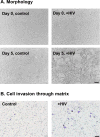HIV Reprograms Human Airway Basal Stem/Progenitor Cells to Acquire a Tissue-Destructive Phenotype
- PMID: 28494859
- PMCID: PMC5521803
- DOI: 10.1016/j.celrep.2017.04.026
HIV Reprograms Human Airway Basal Stem/Progenitor Cells to Acquire a Tissue-Destructive Phenotype
Abstract
While highly active anti-retroviral therapy has dramatically improved the survival of HIV-infected individuals, there is an increased risk for other co-morbidities, such as COPD, manifesting as emphysema. Given that emphysema originates around the airways and that human airway basal cells (BCs) are adult airway stem/progenitor cells, we hypothesized that HIV reprograms BCs to a distinct phenotype that contributes to the development of emphysema. Our data indicate that HIV binds to but does not replicate in BCs. HIV binding to BCs induces them to acquire an invasive phenotype, mediated by upregulation of MMP-9 expression through activation of MAPK signaling pathways. This HIV-induced "destructive" phenotype may contribute to degradation of extracellular matrix and tissue damage relevant to the development of emphysema commonly seen in HIV+ individuals.
Keywords: HIV; MMP-9; airway basal stem/progenitor cells; matrix metalloproteinase-9; reprogramming.
Copyright © 2017 The Authors. Published by Elsevier Inc. All rights reserved.
Figures





Similar articles
-
HIV induces airway basal progenitor cells to adopt an inflammatory phenotype.Sci Rep. 2021 Feb 17;11(1):3988. doi: 10.1038/s41598-021-82143-1. Sci Rep. 2021. PMID: 33597552 Free PMC article.
-
Impaired differentiation of small airway basal stem/progenitor cells in people living with HIV.Sci Rep. 2022 Feb 22;12(1):2966. doi: 10.1038/s41598-022-06373-7. Sci Rep. 2022. PMID: 35194053 Free PMC article.
-
Correlation of HIV-1 detection and histology in AIDS-associated emphysema.Diagn Mol Pathol. 2005 Mar;14(1):48-52. doi: 10.1097/01.pas.0000142168.72253.11. Diagn Mol Pathol. 2005. PMID: 15714064
-
Smoking-Associated Disordering of the Airway Basal Stem/Progenitor Cell Metabotype.Am J Respir Cell Mol Biol. 2016 Feb;54(2):231-40. doi: 10.1165/rcmb.2015-0055OC. Am J Respir Cell Mol Biol. 2016. PMID: 26161876 Free PMC article.
-
IL-13 and TH2 cytokine exposure triggers matrix metalloproteinase 7-mediated Fas ligand cleavage from bronchial epithelial cells.J Allergy Clin Immunol. 2010 Aug;126(2):366-74, 374.e1-8. doi: 10.1016/j.jaci.2010.05.015. Epub 2010 Jul 10. J Allergy Clin Immunol. 2010. PMID: 20624652
Cited by
-
HIV induces airway basal progenitor cells to adopt an inflammatory phenotype.Sci Rep. 2021 Feb 17;11(1):3988. doi: 10.1038/s41598-021-82143-1. Sci Rep. 2021. PMID: 33597552 Free PMC article.
-
Paired ATAC- and RNA-seq offer insight into the impact of HIV on alveolar macrophages: a pilot study.Sci Rep. 2023 Sep 15;13(1):15276. doi: 10.1038/s41598-023-42644-7. Sci Rep. 2023. PMID: 37714998 Free PMC article.
-
Impaired differentiation of small airway basal stem/progenitor cells in people living with HIV.Sci Rep. 2022 Feb 22;12(1):2966. doi: 10.1038/s41598-022-06373-7. Sci Rep. 2022. PMID: 35194053 Free PMC article.
-
Decreased microbiome diversity in the HIV small airway epithelium.Respir Res. 2018 Jul 27;19(1):140. doi: 10.1186/s12931-018-0835-7. Respir Res. 2018. PMID: 30053882 Free PMC article.
-
Acute Human Immunodeficiency Virus (HIV) Infection Presenting With Bilateral Interstitial Pneumonia: Case Report and Discussion of Potential HIV-Induced Interstitial Pneumonia.Open Forum Infect Dis. 2017 Nov 20;4(4):ofx256. doi: 10.1093/ofid/ofx256. eCollection 2017 Fall. Open Forum Infect Dis. 2017. PMID: 29308407 Free PMC article.
References
-
- Atkinson JJ, Senior RM. Matrix metalloproteinase-9 in lung remodeling. Am J Respir Cell Mol Biol. 2003;28:12–24. - PubMed
-
- Beck JM, Rosen MJ, Peavy HH. Pulmonary complications of HIV infection. Report of the Fourth NHLBI Workshop. Am J Respir Crit Care Med. 2001;164:2120–2126. - PubMed
-
- Beeh KM, Beier J, Kornmann O, Buhl R. Sputum matrix metalloproteinase-9, tissue inhibitor of metalloprotinease-1, and their molar ratio in patients with chronic obstructive pulmonary disease, idiopathic pulmonary fibrosis and healthy subjects. Respir Med. 2003;97:634–639. - PubMed
-
- Bhatia NS, Chow FC. Neurologic Complications in Treated HIV-1 Infection. Curr Neurol Neurosci Rep. 2016;16:62. - PubMed
-
- Bhatia R, Ryscavage P, Taiwo B. Accelerated aging and human immunodeficiency virus infection: emerging challenges of growing older in the era of successful antiretroviral therapy. J Neurovirol. 2012;18:247–255. - PubMed
Publication types
MeSH terms
Substances
Grants and funding
LinkOut - more resources
Full Text Sources
Other Literature Sources
Medical
Molecular Biology Databases
Miscellaneous

